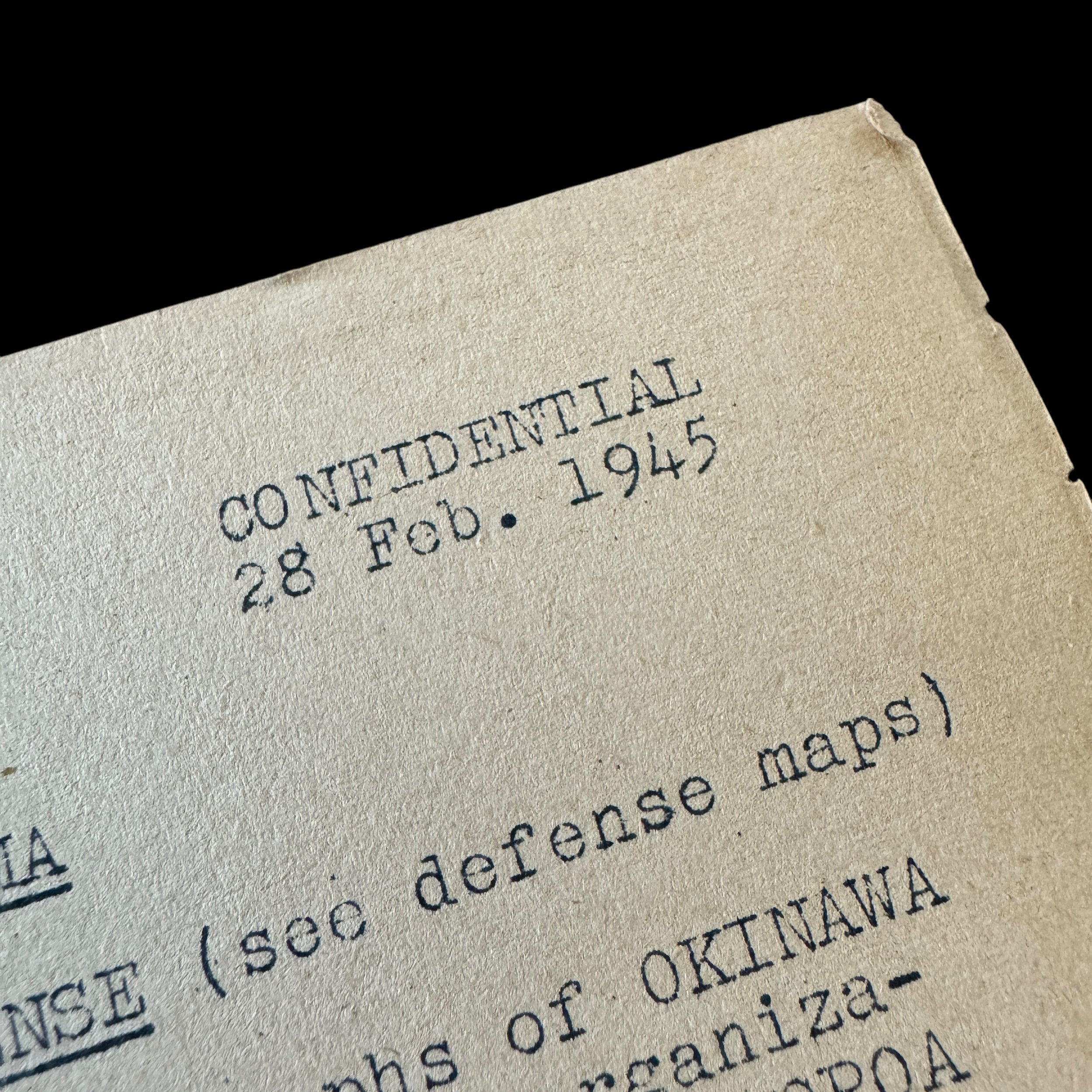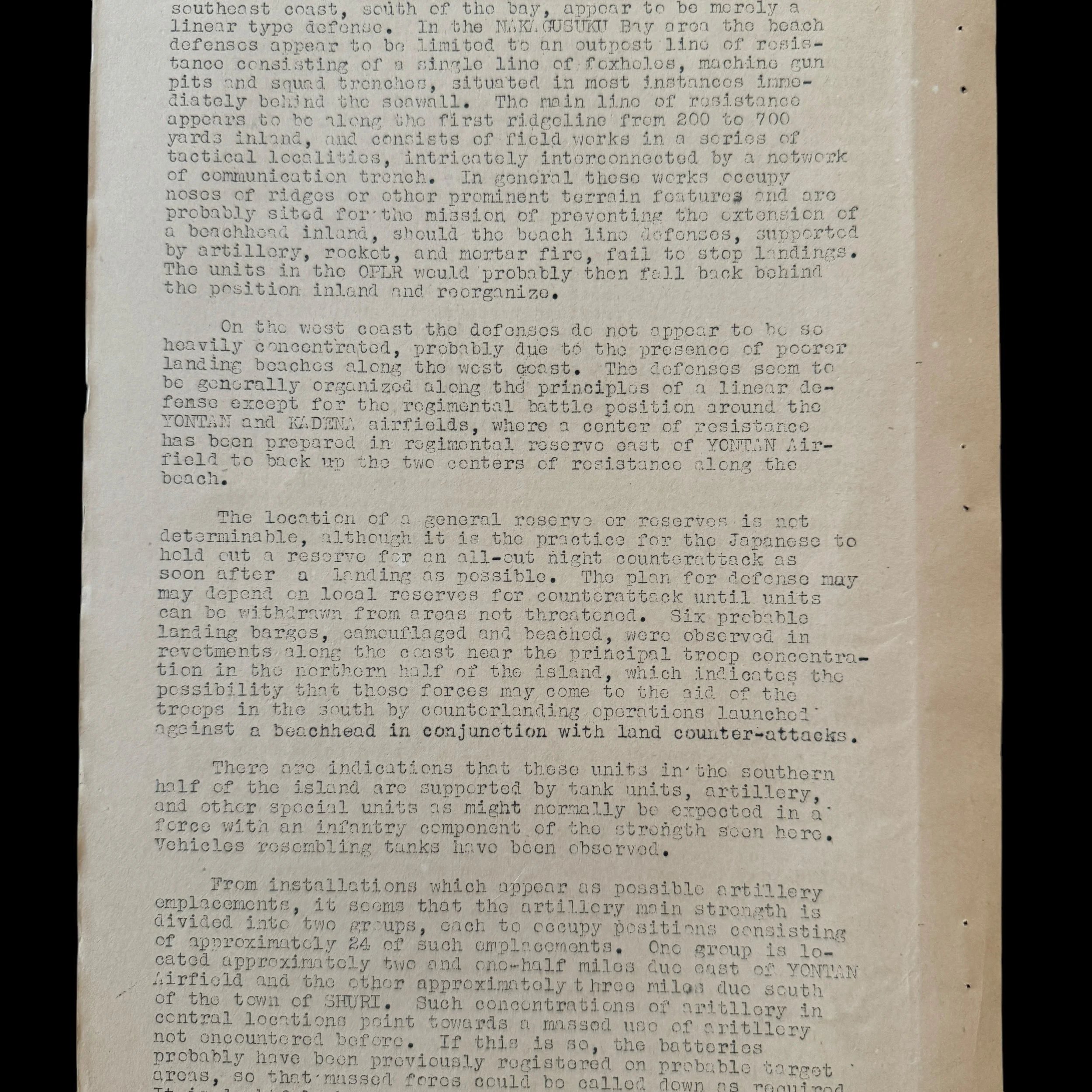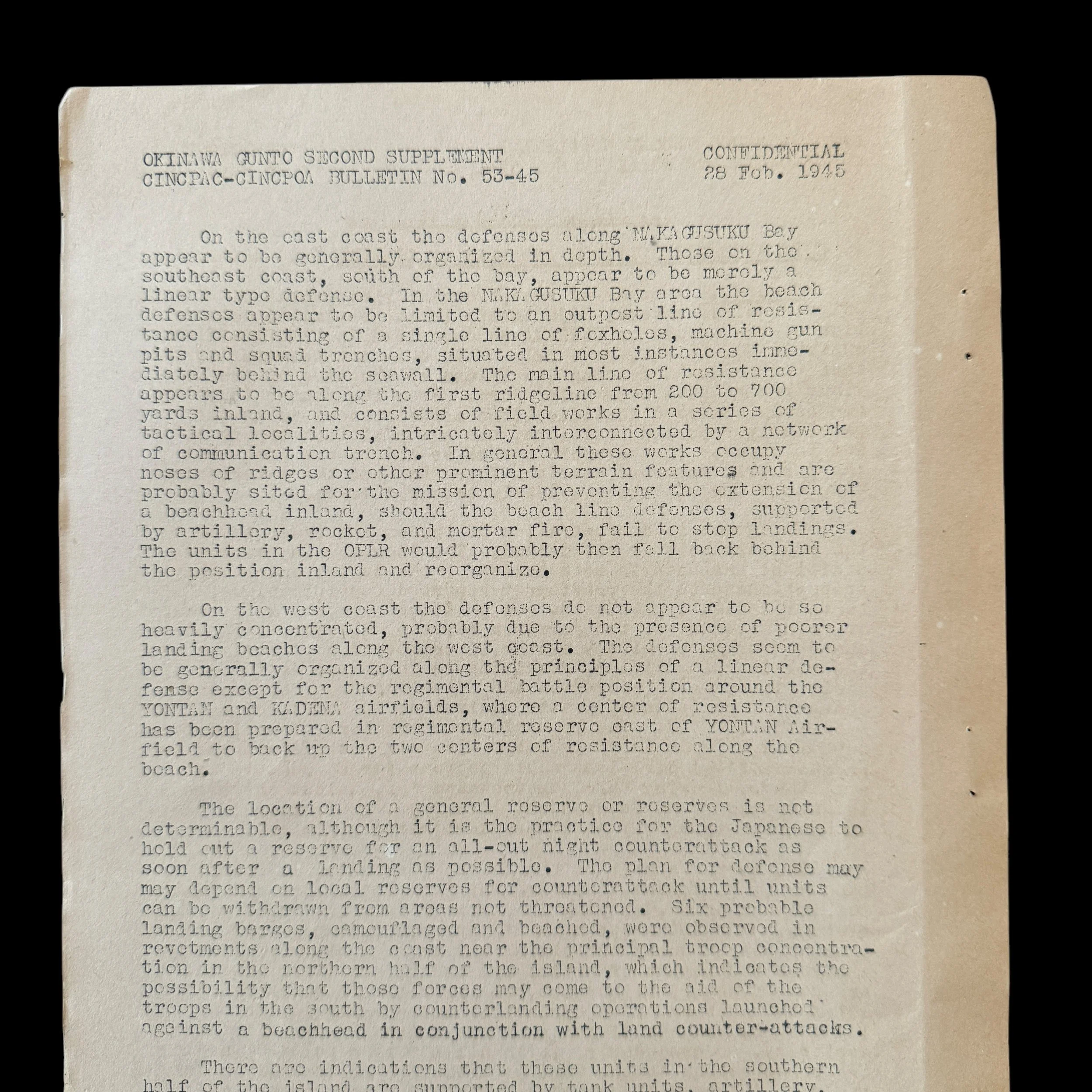RARE! WWII 1945 Original World War II “Headquarters of the Commander in Chief - U.S. Pacific Fleet” CONFIDENTIAL Operation Iceberg Okinawa Gunto Invasion Bulletin (Estimated Japanese Defenses)

















RARE! WWII 1945 Original World War II “Headquarters of the Commander in Chief - U.S. Pacific Fleet” CONFIDENTIAL Operation Iceberg Okinawa Gunto Invasion Bulletin (Estimated Japanese Defenses)
Comes with hand-signed C.O.A. and a full historical write-up
Type: Original World War II “Headquarters of the Commander in Chief - U.S. Pacific Fleet” CONFIDENTIAL Operation Iceberg Okinawa Gunto Invasion Bulletin
Subject: Estimated Dispositions and Plan of Defense on Okinawa and Ie Shima
Campaign: Pacific Theater
Dated: Feb. 1945
Pages: 1 (double-sided)
This rare, museum-grade World War II artifact is an original "Headquarters of the Commander in Chief - U.S. Pacific Fleet" CONFIDENTIAL Operation Iceberg Okinawa Gunto Invasion Bulletin. Produced in extremely limited numbers—fewer than 500 copies produced in 1945—these highly classified bulletins were reserved exclusively for the highest-ranking generals, officers, and intelligence officials directly involved in planning and executing the Okinawa campaign in April 1945.
Operation Iceberg, the largest amphibious assault in the Pacific Theater, required an unprecedented level of preparation and intelligence gathering. This invasion bulletin exemplifies the meticulous planning that defined the campaign, containing detailed intelligence on Japanese defensive positions and the expected strategy for Okinawa and nearby Ie Shima. It provides in-depth analysis of troop deployments, fortifications, and the anticipated challenges posed by the formidable Japanese defense strategy.
The bulletin underscores the gravity of the operation, as Okinawa was strategically critical for its proximity to the Japanese mainland. This document served as a cornerstone for the Allied effort, guiding military leaders in orchestrating the assault, which would become one of the bloodiest and most consequential battles of World War II.
Today, this artifact stands as a testament to the complexity and scale of wartime planning, offering a rare glimpse into the intelligence and strategy that shaped one of the most pivotal moments of the Pacific campaign. Its historical significance and rarity make it a treasured piece of World War II history, capturing the monumental effort behind the Allied push toward victory.
Estimated Dispositions and Plan of Defense on Okinawa and Ie Shima
The Allied invasion of Okinawa and Ie Shima, codenamed Operation Iceberg, was a pivotal campaign during the final stages of World War II. This operation, launched on April 1, 1945, required meticulous preparation and intelligence gathering, as the U.S. sought to confront a deeply entrenched Japanese defense. The plan of defense developed by the Japanese for Okinawa and Ie Shima showcased their determination to delay and inflict maximum casualties on Allied forces, even as their resources dwindled. The dispositions and strategies implemented during the battle reflected the larger strategic shift in Japan's approach to defending the home islands, making Okinawa a critical turning point in the Pacific War.
Okinawa: The Gateway to Japan
Okinawa, the largest island in the Ryukyu chain, was strategically located just 340 miles from the Japanese mainland, making it a vital staging area for a potential invasion of Japan. Recognizing its importance, Japanese forces heavily fortified the island, transforming it into a defensive stronghold designed to inflict catastrophic losses on the advancing Allies. Ie Shima, a smaller island northwest of Okinawa, held strategic value for its airfields, which could serve as a launch point for Allied bombing missions against Japan. Together, Okinawa and Ie Shima represented the final barrier before an assault on the Japanese mainland.
Estimated Japanese Dispositions
The Japanese defense of Okinawa was spearheaded by General Mitsuru Ushijima, commander of the 32nd Army, who orchestrated a layered and deeply entrenched strategy. Intelligence gathered by the U.S. prior to the invasion estimated that the 32nd Army had approximately 77,000 soldiers, supported by an additional 20,000-40,000 conscripts, Okinawan militia, and labor forces. These troops were dispersed across the island in a series of fortified zones designed to exploit the island’s rugged terrain.
Key Defensive Zones on Okinawa
Northern Okinawa:
The northern region of the island, dominated by dense forests and mountains, was lightly defended. Japanese forces anticipated that this area would serve as a diversion rather than the main battlefield. Only small garrisons, including elements of the 44th Independent Mixed Brigade, were stationed here to delay and harass advancing Allied troops.
Central and Southern Okinawa:
The primary defensive positions were concentrated in the southern part of the island, where the terrain provided natural defensive advantages. The Shuri Line, centered around the ancient Shuri Castle, was the heart of Japanese defenses. This fortified network included interconnected caves, bunkers, and artillery emplacements, designed to resist prolonged assaults.
The 27th Tank Regiment and artillery units were positioned to deliver devastating counterattacks when Allied forces advanced.
Western Coast:
Intelligence suggested Japanese forces had mined the western beaches and established strong coastal defenses, anticipating that these areas would be key invasion points. Hidden artillery and anti-aircraft batteries were stationed to resist amphibious landings.
Ie Shima:
Japanese forces on Ie Shima were estimated at around 5,000 troops, including elements of the 3rd Special Base Force and local militia. The flat terrain of Ie Shima made it less defensible than Okinawa, but the Japanese compensated with heavily fortified positions around airfields and a commitment to fighting to the last man.
The Japanese Plan of Defense
The Japanese plan of defense on Okinawa and Ie Shima reflected their larger strategy to transform every island into a costly obstacle for Allied forces. Their approach emphasized attritional warfare, aiming to bleed the Allies dry in terms of personnel and resources. This plan drew on lessons from earlier battles, such as Iwo Jima, where a defense-in-depth strategy had proved effective in prolonging resistance.
Core Elements of the Defense Plan
Deliberate Withdrawal:
Instead of meeting the Allies at the beaches, the Japanese focused on a defensive withdrawal to lure U.S. forces into heavily fortified interior positions. The beaches were mined and lightly defended to slow Allied advances while preserving the core of the 32nd Army.
Defense-in-Depth:
The Japanese constructed a series of defensive lines, with the Shuri Line serving as the centerpiece. This allowed them to fall back in a controlled manner, forcing the Allies to fight for every inch of territory.
Use of Terrain:
Okinawa’s rugged hills, ridges, and caves were incorporated into defensive positions, making it difficult for Allied forces to dislodge entrenched Japanese troops. The Shuri Line, for example, included underground bunkers that could withstand bombardment.
Kamikaze Tactics:
A significant component of the Japanese defense was the use of kamikaze attacks, which targeted Allied ships supporting the invasion. Thousands of planes, including those from the Imperial Japanese Navy’s Fifth Air Fleet, were committed to these suicide missions, aiming to disrupt supply lines and demoralize Allied forces.
Civilian Involvement:
Japanese forces conscripted Okinawan civilians into labor and combat roles, often using them as human shields or forcing them into suicide missions. This tragic element of the battle underscored Japan’s total-war approach.
Allied Intelligence and Preparations
The intelligence gathered by the Allies before the invasion was among the most extensive of the entire Pacific campaign. Reconnaissance flights, captured documents, and interrogation of prisoners provided detailed information about Japanese troop dispositions and fortifications. However, certain elements of the Japanese plan, such as the scale of their kamikaze forces and the complexity of the Shuri Line, were underestimated.
Key Insights from Allied Intelligence:
Japanese forces were heavily concentrated in the south, with minimal defenses in the north.
Coastal defenses were strong but not insurmountable, suggesting that the main battle would occur inland.
Kamikaze tactics would pose a significant threat to the naval fleet, requiring extensive air and naval countermeasures.
The Battle and Outcomes
The Allied invasion of Okinawa began on April 1, 1945, with the largest amphibious landing of the Pacific War. The initial landings were met with surprisingly light resistance, as Japanese forces withdrew to their interior defensive lines. The battle quickly became one of attrition, with Allied forces fighting through heavily fortified positions, including the Shuri Line, over the course of 82 days.
On Ie Shima, the flat terrain provided fewer natural defenses, but the Japanese fought tenaciously, resulting in a week-long battle that secured the island and its airfields for the Allies. The capture of Ie Shima played a critical role in supporting aerial operations during the broader Okinawa campaign.